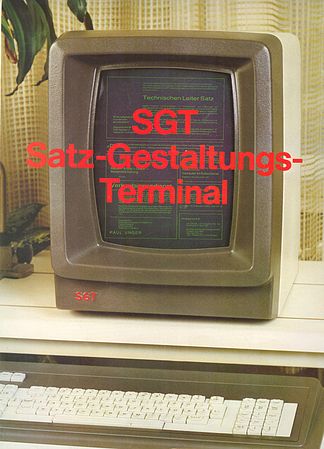Sentence creation terminal
Sentence design terminal (SGT) is the brand name for the first device that can be used in practice and is available on the market, with which one could create graphically correct pages directly on a screen. These were converted into typesetting commands of a Linotype CRTronic or Linotronic photo typesetting machine. So that one was in phototypesetting expose able made without set commands sides. The device represented an enormous step forward, as laborious and time-consuming coding work could be saved. The SGT thus anticipated the later desktop publishing .
history
Hannes Schöllauf, the developer of the SGT, has been experimenting with microprocessor solutions for efficient photo typesetting since around 1975 in his print shop in Haugsdorf , Lower Austria. The first device that could be used was a correction terminal with a simple text screen and a storage facility, first on a cassette recorder and later on 5 1/4 inch floppy disks. In 1982 he began developing a typesetting computer with a high-resolution Motorola graphic screen and a 68000 processor for his own use in his print shop. The technical success of his device and the interest of the Austrian company Berthold & Stempel, which had the sole right of representation for the sale of Linotype photo typesetting machines in Austria and throughout the Eastern Bloc, prompted Schöllauf to found the Grafotron company together with Jörg Wallner in 1983 . With a small number of employees, the production and Europe-wide sales of the new device, which was given the name SGT, began. Schöllauf got a managing director for his print shop, to whom he sold the company three years later. He now only devoted himself to his new development.
The SGT was further developed in the following years and successfully sold throughout Europe. Through the SGT, Berthold & Stempel was also able to sell many Linotype photo typesetting machines that would not have been for sale without SGT. For example, Moscow Pravda was made with SGTs until it was discontinued in 1996.
In 1989 the Austrian patent office granted a patent for the "central unit with memory" of the SGT under the number 389014.
At the end of the 1980s, Linotype GmbH in Eschborn , Germany, acquired the license rights for production and distribution. In the early 1990s, however, desktop publishing overwhelmed the SGT's success.
functionality
A page was designed interactively on the screen, which was very high-resolution for the time. It was divided into different blocks (text, lines, frames, images, etc.). The individual blocks could be created, positioned, provided with text and changed. You could see the result graphically correctly on the screen immediately after each individual work step. After completing the work, the SGT's computer converted the entire content into typesetting commands of a Linotype CRTronic or Linotronic photo typesetting machine. The encoded data was transferred to a Linotype phototypesetting machine either online or with a data carrier and then exposed on paper or film. This saved the tedious and time-consuming coding of typographic work on the text screen of the photo typesetting machine, which was previously necessary. The rationalization effect was therefore enormous and contributed significantly to the great success of the device.
Technical details
A 68000 from Motorola was used as the processor. The screen of the first version of the SGT was also from Motorola. It had a green glowing phosphor and was interlaced to increase resolution. The phosphor was photoluminescent to minimize flicker. The video frequency was 42 MHz. A 7220 from NEC served as the video controller. 147 kB static and 2 MB dynamic RAM were used as memory. The bootstrap loader was stored in an EPROM. A 5 1/4 inch floppy disk drive served as mass storage. From 1987 there was the SGT as SGT-PC. A CPU card from LP-Elektronik with a 68000, connected to a screen controller from Grafotron for a graphic screen with an NEC 7220 turned the PC into a double CPU computer. The peripheral devices such as keyboard, mouse, hard disk and floppy disk were controlled by the DOS operating system, the sentence creation program ran on the 68000, and the graphic screen was controlled by the 68000 and the NEC 7220.


